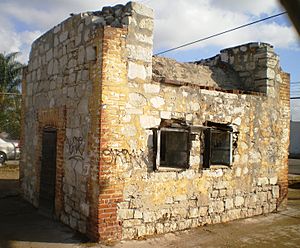Powder Magazine (Camp Drum) facts for kids
Quick facts for kids Powder Magazine (Camp Drum) |
|
|---|---|

Powder Magazine (Camp Drum)
|
|
| Location | 561 E. Opp St., Wilmington, Los Angeles, California |
| Built | 1862 |
| Governing body | private |
| Designated | August 10, 1982 |
| Reference no. | 249 |
| Lua error in Module:Location_map at line 420: attempt to index field 'wikibase' (a nil value). | |
The Powder Magazine from Camp Drum is a special historic building. It's known as a Los Angeles Historic-Cultural Monument. You can find it in the Wilmington area of Los Angeles, California, not far from the Port of Los Angeles.
This building was constructed in 1862. It's a strong brick and stone structure, about 20 feet by 20 feet in size. Its main job was to safely store gunpowder during the American Civil War. The Powder Magazine was once part of a larger military base called Camp Drum.
Contents
The Powder Magazine: A Civil War Story
The Powder Magazine is a key part of California's history during the American Civil War (1861-1865). It was built to keep gunpowder safe for soldiers. This was very important because gunpowder was needed for cannons and guns.
Why Was Camp Drum Built?
When the Civil War began, leaders in the Union (the Northern states) were worried about Los Angeles. Many people living there had recently moved from the Southern states. In the 1860 Presidential election, more people in Los Angeles voted for John C. Breckinridge, who supported the Southern states, than for Abraham Lincoln.
Phineas Banning, who founded Wilmington (then called New San Pedro), wrote to President Lincoln. He warned that the Union might lose California's support if something wasn't done. To help keep California loyal to the Union, Camp Drum was built.
Camp Drum's Important Role
Camp Drum was constructed between 1862 and 1863. It became the main base for the California Column. This was a group of soldiers led by Colonel James Henry Carleton. Between 2,000 and 7,000 soldiers were stationed at Camp Drum during the war.
Because so many soldiers were there, Wilmington became a busy town. Its population actually grew larger than Los Angeles during the war years! Camp Drum played a big part in keeping peace and order in Southern California. It also helped protect the area from any threats during the conflict.
Rediscovering History
Today, the Powder Magazine is one of only two buildings left from the original Camp Drum. The other building is the Drum Barracks, which is now a Civil War museum run by the City of Los Angeles.
Over the years, the Powder Magazine was used for different private purposes. At one point, another building was even built around it. When that larger building was torn down, the Powder Magazine was "re-discovered." To save it from being destroyed, it was officially named a Historic-Cultural Monument (HCM #249) in August 1982. For more than 20 years, it has stood on a fenced-off empty lot, just two blocks south of the Drum Barracks. It reminds us of a very important time in California's past.

